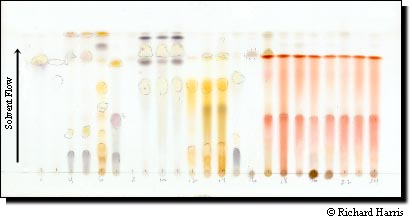
How are Lichens Identified?
One method used for identification in lichens consists
of some simple spot tests. There are three basic chemical tests that may
or may not yield a color change when applied to a lichen. Two of these
tests have been used for over 100 years. As a result, many species have
been based solely on their chemistry since the end of the nineteenth century.
 Today, thin layer chromatography (TLC) is the most widely
used method of identification in lichens. Extracts of the unknown lichens
are spotted on a TLC plate. The TLC plate is immersed in a solvent mixture
(different solvents yield different results), and the different compounds
migrate upward characteristic distances with the solvent. The plate is
then examined under UV light to check for fluorescence (which is caused
by certain compounds and can be useful in identifying the lichen). Next,
the TLC plate is sprayed with 10% sulfuric acid, and is heated. The compounds
of each lichen develop a distinct color, which, together with the distance
migrated, identify the compound. This can be seen in the figure above.
Each lane on the plate represents an extract from a different lichen. The
figure shows that one extract from a lichen may be composed of several
different compounds that appear as different colors on the TLC plate and
migrate different distances. The data collected from a TLC plate is one
set of characters used in combination with features of the thallus and
ascomata to determine the species.
Today, thin layer chromatography (TLC) is the most widely
used method of identification in lichens. Extracts of the unknown lichens
are spotted on a TLC plate. The TLC plate is immersed in a solvent mixture
(different solvents yield different results), and the different compounds
migrate upward characteristic distances with the solvent. The plate is
then examined under UV light to check for fluorescence (which is caused
by certain compounds and can be useful in identifying the lichen). Next,
the TLC plate is sprayed with 10% sulfuric acid, and is heated. The compounds
of each lichen develop a distinct color, which, together with the distance
migrated, identify the compound. This can be seen in the figure above.
Each lane on the plate represents an extract from a different lichen. The
figure shows that one extract from a lichen may be composed of several
different compounds that appear as different colors on the TLC plate and
migrate different distances. The data collected from a TLC plate is one
set of characters used in combination with features of the thallus and
ascomata to determine the species.
Click here to return
to original document
